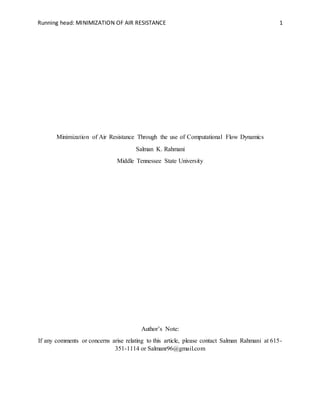
Minimizing Air Resistance with CFD Simulations
- 1. Running head: MINIMIZATION OF AIR RESISTANCE 1 Minimization of Air Resistance Through the use of Computational Flow Dynamics Salman K. Rahmani Middle Tennessee State University Author’s Note: If any comments or concerns arise relating to this article, please contact Salman Rahmani at 615- 351-1114 or Salmanr96@gmail.com
- 2. MINIMIZATION OF AIR RESISTANCE 2 Introduction As a solid object travels in any direction, it will encounter drag. In addition, as it moves, it creates a rift in the airstream or hydro stream that must re-seam itself back together as the object moves away from a particular position. This causes resistance on the object because almost always, the stream that it splits does not have a smooth transition back into itself. One geometric shape worth examining is the rearward-facing step (RFS). To calculate the drag, the program (ANSYS-Fluent) takes the various aerodynamic forces as well as the hydrodynamic forces into account and calculates the parasitic drag induced on the moving object. In the research, Nick Myhre and I will be conducting, we will analyze how the airstream or hydro stream reacts to the RFS geometric shape as well as the amount of drag produced based on different atmospheric conditions. After the simulations are completed, Nick and I will assess the computations and make modifications to the step to try and reduce the drag. Background Nick and I are not the first individuals to examine the rearward facing step under various atmospheric/airstream conditions. In fact, many studies have been conducted using the RFS. For example, an article was written by N Kasagi and A Matsunaga concerning how much energy the RFS was consuming, known as the energy budget (Le, H., Moin, P., & Kim, J. (1997). Direct numerical simulation of turbulent flow over a backward-facing step. Journal of fluid mechanics, 330, 349-374). In addition, another article was written concerning the magnitude of the shear layer based on different variables Kim, J., Kline, S. J., & Johnston, J. P. (1980). Investigation of a reattaching turbulent shear layer: flow over a backward-facing step. Journal of Fluids Engineering, 102(3), 302-308). Although we might use the same computational approach for CFD, our goals are not the same. Nick and I are testing varying geometric objects using the RFS
- 3. MINIMIZATION OF AIR RESISTANCE 3 as a base to minimize drag instead of what the previous experiments were concerned with; which was calculating the magnitude of the shear or the energy budget. Purpose The purpose of this research is to compute the drag acting on the rear of the object, through the use of the ANSYS-Fluent software package. Not only is our goal just to compute the amount of drag but also to perform modifications to the rear to try and minimize it as well. In addition, the reason that I am performing this research is to gain exposure to CFD software which is extremely beneficial to me. This is due to the fact that a high percentage of aerospace engineers (my major) rely on this software for their complex computations. Methods The method that will be utilized in this project will be mostly analysis of the computational data composed by the ANSYS-Fluent Software while following pre-set guidelines laid out by Dr.Callender as to which geometric shapes to simulate. We will begin our first simulation with the traditional step shape (RFS). We will run the computations with the traditional shape for a total of seven trial runs with the Reynolds numbers ranging from extremely low to extremely high. After the simulations are finished with the traditional shape, we will then run the next simulation with the same atmospheric settings as we did before but this time with a cylindrical geometric shape rotating at speeds from zero to twice the speed of the airstream. This is expected to reduce the drag induced upon the object substantially. After testing the cylindrical model, we will then shrink the cylinder down to half the step size and again run a series of tests. After all this is completed, we will record and compare the data to see which modification was the most effective as well as why it was the most versatile.
- 4. MINIMIZATION OF AIR RESISTANCE 4 Timeline The total duration of this project will range from September 22, 2015 to April 31, 2016 but my involvement will range from September 22, 2015 to December 11, 2015. Following dates are approximate. September 21-October 2 Traditional (Step) Model Simulation and data analysis October 5-October 30 Cylinder Model (equaling the step height with rotational speeds from zero to twice the speed of the truck) testing and analysis November 2-November 27 Cylindrical Model (with half of the height of the first cylinder model. Again, rotating at zero to twice the speed of the truck) trial November 30-December 11 Harness computated data from ANSYS-Fluent software
- 5. MINIMIZATION OF AIR RESISTANCE 5 Collaboration with Research Mentor For the duration of my involvement, Dr. Callender will act as the Chief Supervisor whilst Nick Myhre and I, will be conducting the research as Undergraduate Researchers. Along the way, Dr. Callender will coordinate with us if he notices any errors in our calculations and/or research methods. Conferences between us have not been scheduled on a patterned basis but will be set- up if any complications arise.
